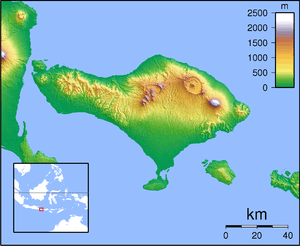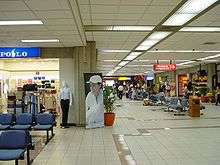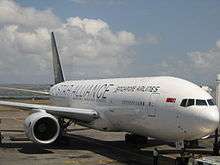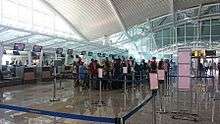Ngurah Rai International Airport
| Ngurah Rai International Airport Bandar Udara Internasional Ngurah Rai | |||||||||||
|---|---|---|---|---|---|---|---|---|---|---|---|
 | |||||||||||
 | |||||||||||
| IATA: DPS – ICAO: WADD formerly WRRR | |||||||||||
| Summary | |||||||||||
| Airport type | Public | ||||||||||
| Owner | Government of Indonesia | ||||||||||
| Operator | PT Angkasa Pura I | ||||||||||
| Serves | Denpasar | ||||||||||
| Location | Kuta, Badung, Bali | ||||||||||
| Hub for | |||||||||||
| Elevation AMSL | 14 ft / 4 m | ||||||||||
| Coordinates | 08°44′53″S 115°10′03″E / 8.74806°S 115.16750°ECoordinates: 08°44′53″S 115°10′03″E / 8.74806°S 115.16750°E | ||||||||||
| Website | bali-airport.com | ||||||||||
| Map | |||||||||||
 DPS Location in Bali | |||||||||||
| Runways | |||||||||||
| |||||||||||
| Statistics (2015) | |||||||||||
| |||||||||||
Ngurah Rai International Airport (Indonesian: Bandar Udara Internasional Ngurah Rai) (IATA: DPS, ICAO: WADD), also known as Denpasar International Airport, is the main airport in Bali, located 13 km south of Denpasar. Ngurah Rai is the third busiest airport in Indonesia after Soekarno–Hatta International Airport and Juanda International Airport. In 2011 Ngurah Rai International Airport recorded 39,509 international and 64,262 domestic flights which carried 6,177,044 and 6,594,830 passengers respectively. The 2011 passengers were doubled within 5 years.[1] The airport has category IX and is capable of serving aircraft up to the size of Boeing 747-400.[2]
The airport is named after I Gusti Ngurah Rai, a Balinese hero who died on 20 November 1946 in a puputan (fight to the death war) against the Dutch at Marga in Tabanan where the Dutch defeated his company with air support, killing Rai and 95 others during the Indonesian Revolution in 1946.[3]
Location
The airport is located in Tuban between Kuta and Jimbaran and is close to the tourist locations of southern Bali; the resort center of Kuta is 2.5 km north of the airport. The capital of Bali, Denpasar, is located nearby.
History
Early years
The Pelabuhan Udara Tuban, or Tuban airfield, was established in 1931 at the narrowest point on the southern coast of Bali. The airport was originally built as a simple 700 m long airstrip by the Dutch Colonial administration's Voor Verkeer en Waterstaats public works office.[4] When first established the site only had a few huts and a short grass runway. The northern end lay in the Tuban village graveyard and in the south it occupied previously vacant land. The location in this area of the island has subsequently facilitated arrivals and departures over the ocean with minimal noise and overflights intruding upon populated areas. The current airport has an east–west aligned runway and associated taxiway, with over 1,000 m of that runway's length projecting westward into the sea.
In 1942 the airstrip was in use to stage fighter and bomber operations and received bombing damage from Japanese forces. It was repaired using PSP pierced steel planking. The Japanese armed forces occupied Bali during the Second World War seizing the airport on 19 February 1942.[5] A poorly motivated garrison of 600 Dutch led Balinese militia deserted almost immediately as the Japanese invaded the island. Their Dutch commander was to learn that through a misunderstanding of his orders, Tuban airfield had not been destroyed by explosives as he had ordered. Apparently his order not to delay the demolition was misread by the demolition engineers at the airstrip who thought instead that he wanted the operation delayed. This confusion allowed the Japanese to take the airfield completely intact.[6] During the occupation period the Japanese made improvements to the runway at the airport. In the five years from 1942 to 1947 the length of the runway was extended to 1,200 m from the original 700 m.[5] Many Balinese identified the Japanese invaders as being potential liberators from the Dutch colonial authorities who were unpopular on the island. There was never a significant Japanese fighter squadron stationed in Denpasar although it was within the field of tactical air operations conducted from both Surabaya and Allied airbases in northern Australia. More so the taking of Tuban airfield and the island of Bali deprived the allied forces of a fighter staging field en route from Australia to defend Java. At the time the airport was still called Tuban Airfield, named after the local fishing village.
In 1949 a Terminal building and other aviation facilities were constructed and a simple wooden flight control tower was erected. Aviation communication was by morse code tranceiver.[5] In 1959 president Sukarno sought to further develop the airstrip. The new facilities were built as part of a $13 million (Rp 35 billion in 1959) renovation project.[7]
To allow jet aircraft such as the Douglas DC8 and the Boeing 707 to operate from Bali, it was necessary to extend the runway westward into the sea as any potential eastern extension of the runway was by now blocked by the expansion of the local fishing village. The International Airport Tuban was developed with the decision by the Indonesia government to further develop and rebuild the terminal building and extend the existing airport runway westward by 1,200 m to a length of 2,700 m with two 100 m overruns. The project, which lasted from 1963 to 1969 was named Project Tuban Airport and was for preparation of Tuban Airport for international operations. Land reclamation to project the runway and the two overruns by 1,500 m was achieved by taking material from the limestone rocks at Ungasan and sand from the river Antosari–Tabanan. With the completion of the temporary terminal and runway project at the Tuban Airport, the government inaugurated international air service on 10 August 1966.[8]
To meet the ever increasing number of passengers the terminal buildings were extended with construction of an International Terminal building undertaken from 1965 to 1969. This added international facilities to the existing domestic passenger terminal. The new Ngurah Rai International Airport was inaugurated the on 1 August 1968 by the then Indonesian President Suharto as Pelabuhan Udara Internasional Ngurah Rai, or Ngurah Rai International Airport. The name came from I Gusti Ngurah Rai who was a significant national republican figure during the struggle for independence in Indonesia.[8]
The current airport is named after I Gusti Ngurah Rai, an Indonesian National Hero an Indonesian republican who died on 20 November 1946 in a puputan (fight to the death) against the Dutch at Marga in Tabanan where the Dutch defeated them with the aid of aircraft, killing Rai and 95 others during the Indonesian Revolution in 1946.[3]
The earlier extension of the runway subsequently caused disruption of natural sand flow along the coast. By 1975 the anticipated rise in passenger volumes was already overburdening the older terminal and works were commenced on a new international passenger terminal, with completion in 1978. The old International Terminal was then converted into the now Domestic Terminal and the old Domestic Terminal was converted to use as the Cargo and Catering facilities building.
On 1 October 1980 based on the Government Decree No.26 of the year 1980, the management of Ngurah Rai International Airport was passed over from the Directorate of Air Transportation to Perum Angkasa Pura. Since then the aviation facilities including the apron, the terminal and other buildings have been further developed by Perum Angkasa Pura. In 1986 by national government decree No. 25 Perum Angkasa Pura changed name to become Perum Angkasa Pura I. The Indonesian term Pelabuhan Udara was changed into Bandara Udara based on the Transportations Ministerial Decision No.213/HK.207/Phb-85 on 1 September 1985. Commencing 1 October 1989 until 31 August 1992 further major airport improvement works were undertaken including a landing strip extension to 3,000 m, taxiway relocations, apron expansion, passenger and cargo building expansions and the further development of air navigational and aircraft fueling facilities. With the issuing of the Governmental Decree No.5-year 1992 then Perum Angkasa Pura I was converted into a PT. (Persero) Angkasa Pura 1. Company activities include aviation facilities provisions and airport services. Project Phase II was carried out 10 February 1998 with planned completion June 2000.[9]
Development since the 2000s
In 2000, the airport recorded 43,797 domestic and international flights, carrying 4,443,856 passengers.[7] By the end of April 2011, the airport's terminals handled 11.1 million passengers a year (yoy), exceeding its capacity of 8 million. PT Angkasa Pura I will relocate 35 guest houses to accommodate the expansion, which is expected to occupy up to 265.5 hectares of land for a new access road to the airport and a new airport building, the construction of a new flyover, enlarge airport terminal and improve luggage handling system.[10] There have been several plans made seeking a solution to the expansion problems at Ngurah Rai International airport. There have been proposals to develop a north–south runway however existing land use in the areas adjacent to the airport makes this idea unfeasible due to the considerable land purchase costs. A completely new airport was proposed to ease the airport' congestion due to the area surrounding the existing airport not supporting significant long-term expansion. A masterplan was announced for works at this airport for 2009–2011, which includes a new international terminal with 120,000 square meters in area to be built and the existing international terminal with area of 56.000 square meters will be renovated for use as a new domestic terminal. The new international terminal opened in November 2013, while the domestic terminal opened on 17 September 2014 with an area of 65,800 square meters, eight departure and seven arrival gates, five passenger boarding bridges, five conveyor belts, as well as more number of counters — 62 for check-in, 4 for transit and 19 for ticketing.[11] And can accommodate 25 million passengers a year until 2025.[12][13] This provided land for building a new horseshoe shaped building for 17 passenger aircraft parking at the east area on the former domestic terminal. The plan also incorporated a runway extension to 3,600 m. Currently airplanes up to the size of Boeing 777-300ER, Boeing 747-400 and Boeing 787 Dreamliner can use the airport. Although Ngurah Rai International Airport already has a parking slot for the Airbus A380, some taxiway turns are still being widened to accommodate the superjumbo jet.[14]
In 2005 the Transportation Security Administration of the United States of America determined that the airport was not meeting the security standards of the International Civil Aviation Administration,[15] however this warning was lifted in 2007.[16] Currently around 800 of the total employees at Ngurah Rai are security personnel.[17]
Masterplan





The master plan was originally proposed prior to the tourism downturn in Bali following the two bombing incidents. The airport and Bali's economy, which are almost exclusively dependent on tourism suffered considerably from the decline in tourists. Since these proposals were originally made the tourism sector has experienced a gradual recovery and a new international airport has been built on the nearby island of Lombok to the east of Bali. The new Lombok International Airport was first announced in 2005. The Island of Lombok is to the immediate east of Bali. A stage one completed runway of 2,750 m opened on 1 October 2011 and a proposed stage 2 development of 4,000 m is planned for the new facility. It is anticipated that some of the requirement for expansion of Bali's Ngurah Rai International Airport will be mitigated with the opening of the new facility in Lombok. Lombok is approximately 25 mins away by air from Ngurah Rai International Airport.[18]
Plans to expand the international and domestic terminals at Ngurah Rai International Airport were announced in September 2008 with estimated costs of up to Rp 1 trillion (US$110.10 million) and a 2011 planned completion date. The total area of the domestic and international terminals was to be increased from 83,000 m2 to about 200,000 m2, with 130,000 m2 provided for the international terminal and 70,000sq m for the domestic terminal.[19] In December 2008, the operating company announced that the expansion works at Tuban would begin in early 2009.
Airport Facilities Development and Flight Safety (FBUKP) Phase III for Ngurah Rai International Airport includes the terminal building, a multi story car parking building, and apron. The plan involves developing the site of the current domestic terminal which will be used as a new 120,000 m2 international terminal with the existing international terminal being converted into the new domestic terminal. It is projected that subsequent to these plans being completed Ngurah Rai International Airport will be able to accommodate up to 25 million passengers per annum.[12]
In October 2010 former vice president Jusuf Kalla proposed a massive overhaul of the airport's facilities. Heru Legowo, general manager of Perusahaan Angkasa Pura 1 the state-owned airport management company that owns and operates Ngurah Rai airport, described a detailed renovation plan, which includes expanding the domestic and international terminals and renovating the airport's interior and exterior.
The project planned to expand the international terminal to 120,000 m2 and the domestic terminal to 65,000 m2. The cargo terminal was to be expanded to 5,000 m2 and the airport management planned to build a three-story, 1,500 vehicle parking lot on a 39,000 sq m plot. The domestic apron was to be increased to 314,000 m2 from 214,500 m2 to accommodate more wide bodied larger aircraft such as the Boeing 747 and Airbus A330. Apparently the increasing number of flights forced the company to make plans to improve the airport's facilities. Renovation and expansion programs were to be limited to the existing airport land envelope and the new projects were to absorb the company's surrounding residential, office and school complexes. Land in the prime tourism location surrounding the airport, now home to luxury hotels and restaurants, averages around Rp 1 billion for 100 m2. The planned airport buildings were described as a blend contemporary and Balinese traditional architectural elements as required by provincial bylaw No 5/2005 on building designs.
In October 2010 the Jakarta Post reported that Ardita, deputy director of Ngurah Rai airport's Extension and Renovation Project had made an announcement that the new terminal will be able to handle 20 million passengers a year by 2020 and up to 30 million passengers per year by 2030.[20]
In November 2010 the government allocated Rp 1.9 trillion to realise the terminal improvement plan. Plans are for the work to be completed prior to the expected demands of the APEC Summit which will begin on the island in 2013. Rp 3.5 trillion funding was announced for the combined airport and the previously planned connecting toll road projects, with Rp 1.9 trillion allocated to the airport. May 2013 was set as the deadline for both projects.[21]
Angkasa Pura I planned to demolish 143 houses in the complex currently occupied by Angkasa Pura employees by February 2011. Bali Tourism Development Corporation (BTDC) said the toll road project was going to require the reclamation of around 100 m2 of existing mangrove forest.[22]
Plans are for the work to be completed prior to the expected demands of the APEC Summit which will begin on the island in 2013. Rp 3.5 trillion funding was announced for the combined airport and connecting toll road projects, with Rp 1.9 trillion allocated to the airport. May 2013 was set as the deadline for both projects.[17] The first construction stage will initial on 1 September 2011 which enable the airport to accommodate up to 25 millon passengers a year or twice its current capacity. The project will also add Visa on Arrival counters from the existing 7 to 35 and Immigration counters from the present 12 to 20. The airport will also use a state-of-the-art security and baggage handling system as the first airport in Indonesia use it.[23]
New airport
With about 12 to 15 percent passengers growth annually, the airport will reach 20 million passengers per annum in 2017, which is the current airport's full capacity. Lengthening the existing runway is not possible either due to the densely populated areas adjacent to the airport, or environmental concerns regarding land reclamation. A site for a new, larger airport with two runways has been identified in the northern part of Bali in the east part of Buleleng Regency.
Terminals and facilities

The International Terminal is located in the newer L shaped terminal whilst the Domestic Terminal is located in the older adjacent building a short distance to the south east of the international terminal. The airport has 18 gates: 8 in the Domestic terminal, and 10 in the International terminal. The two terminals are separated by the Festival Plaza.
The International terminal has a Balinese architectural theme and has separate departure and arrival halls. Its capacity is up to 4,938,840 passengers a year. The departures area has 62 check-in counters that are equipped with electronic scales and luggage conveyors. Ten of the international gates have Jet Bridges and automated aircraft parking systems. The international departure lounge areas have a total capacity of 3,175 passengers.[24]
Operated since September 17, 2014, the New Domestic Terminal area is 65,800 square meter or four times larger than the old one. It can serve up to 9.4 million passengers a year, has 62 check in counters, 4 transit & transfer counters, 19 ticketing counters, 8 boarding gates and 7 arrival gates which are provided by 5 aviobridges (garbarata), and 5 unit conveyor belts.[25]
The airport operates a fleet of buses to ferry passengers to and from low cost aircraft which do not use an aerobridge. Domestic travelers and also some international travelers are often ferried to aircraft parked on the apron between the domestic terminal and the cargo terminal to the east of the International and Domestic terminals using these buses. The terminal also has prayer rooms, smoking areas, showers and massage services. Various lounge areas are provided, some including children's play areas and movie lounges, broadcasting movies, news, variety & entertainment and sport channels.
Because about 500 private aircraft lands at the airport every month, the airport authority has built an apron at the south of the airport with a special exit gate which can accommodate 14 narrow/small bodied airplanes.[26]
Airlines and destinations
Passenger
Cargo
| Airlines | Destinations |
|---|---|
| Garuda Indonesia Cargo | Osaka–Kansai, Singapore |
Accidents and incidents
| Year | Date | Event | Casualties |
|---|---|---|---|
| 1974 | 22 April | Pan Am Flight 812, a Boeing 707, crashed into a mountain while preparing for final approach. | All 107 passengers and crew were killed.[41] |
| 1978 | 5 October | Douglas C-47A PK-NDI of Merpati Nusantara Airlines caught fire whilst parked and was destroyed.[42] | |
| 2013 | 13 April | Lion Air Flight 904 with 101 passengers and 7 crew members aboard undershot the runway while landing and ditched in the open sea. The airplane was arriving from Bandung, West Java.[43][44] | All 101 passengers and 7 crew survived. 22 were injured. |
Statistics
 |
In 2011 there were 12,771,874 passengers 6,177,044 in international flights and 6,594,830 in local flights.
The following table shows total passenger numbers.
| Year | Passengers |
|---|---|
| 2011 | 12,771,874 |
| 2012 | - |
Footnotes
- ↑ "Airport to be more selective of airlines". 17 March 2012.
- ↑ "Taksi Membawa Penumpang Terbakar di Tol Bali Mandara". September 25, 2015.
- 1 2 Pringle, p 161
- ↑ http://www.thejakartapost.com/news/2010/09/06/ngurah-rai-airport-get-multimilliondollar-facelift.html Ngurah Rai airport to get multimillion-dollar face-lift Wasti Atmodjo and Rita A.Widiadana, The Jakarta Post, Denpasar Mon, 9 June 2010, accessed 11 October 2010
- 1 2 3 http://dps.ngurahrai-airport.co.id/i/eng/sejarah.php Airport history, accessed 11 October 2010
- ↑ http://www.netherlandsnavy.nl/battle_balitimor.html Fire in the Night:The loss of Bali and Timor, accessed 11 October 2010
- 1 2 http://www.thejakartapost.com/news/2010/09/06/ngurah-rai-airport-get-multimilliondollar-facelift.html Ngurah Rai airport to get multi-million-dollar face-lift, Wasti Atmodjo and Rita A.Widiadana, The Jakarta Post, Denpasar Mon, 9 June 2010, accessed 11 October 2010
- 1 2 http://dps.ngurahrai-airport.co.id/i/eng/sejarah.php Airport history, 1930–2010, accessed 11 October 2010
- ↑ http://www.bali-tourism-board.com/airport-service.html Bali Tourism Board, Aircraft service facilities – Landing Strip, accessed Oct 2010
- ↑ "Bali set to expand airport amid traffic overload". Retrieved 4 June 2015.
- ↑ "Welcome to Bali". 18 September 2014.
- 1 2 http://dps.ngurahrai-airport.co.id/i/eng/sejarah.php Airport Facilities Development and Flight Safety (FBUKP) Phase III, accessed 11 October 2010
- ↑ "Bali airport expansion to be completed by end of June". 19 April 2014.
- ↑ "Bandara Ngurah Rai Siap di Landasi Pesawat Berbadan Lebar". 26 December 2014.
- ↑ "TSA Finds Security at Bandara Ngurah Rai International Airport Does Not Meet International Standards" (Press release). Transportation Security Administration. 23 December 2005. Retrieved 10 July 2007.
The Transportation Security Administration (TSA) today announced that the Bandara Ngurah Rai International Airport in Bali, Indonesia does not meet international security standards, and the department is taking action to warn travelers of this security deficiency.
- ↑ "U.S. lifts Bali airport security alert". Reuters. 11 October 2007.
- 1 2 http://www.thejakartapost.com/news/2011/01/11/ngurah-rai-renovation-cost-rp-19-trillion.html Ngurah Rai renovation to cost Rp 1.9 trillion Mariel Grazella, The Jakarta Post, Jakarta 1 November 2010, accessed 12 February 2011
- ↑ http://www.angkasapura1.co.id/index.php/berita/show/id/36
- ↑ Ni Komang Erviani (9 September 2008). "Ngurah Rai airport to be expanded". The Jakarta Post. Retrieved 12 February 2011.
- ↑ http://www.thejakartapost.com/news/2010/09/06/ngurah-rai-airport-get-multimilliondollar-facelift.html Ngurah Rai airport to get multi-million-dollar face-lift Wasti Atmodjo and Rita A.Widiadana, The Jakarta Post, Denpasar Mon, 9 June 2010, accessed 11 October 2010
- ↑ Mariel Grazella (11 January 2011). "Ngurah Rai renovation to cost Rp 1.9 trillion". The Jakarta Post, Jakarta. Retrieved 12 February 2011.
- ↑ "Airport expansion to affect residential sites". The Jakarta Post. 1 December 2010. Retrieved 12 February 2011.
- ↑ "Ngurah Rai airport kicks off massive expansion project". 22 August 2011.
- ↑ http://www.bali-tourism-board.com/airport-service.html Bali tourism board Aircraft service facilities at DPS
- ↑ "Terminal Domestik Baru Bandara Ngurah I Gusti Ngurah Rai Resmi Beroperasi Hari Ini". September 17, 2014. Retrieved September 16, 2015.
- ↑ "New apron for private jets, charter flights". 24 May 2013.
- ↑ http://www.airniugini.com.pg/wp-content/uploads/2014/03/NS14SCHINT.pdf_
- ↑ "FLIGHT SCHEDULE". Air Timor cheap tickets Singapore to Dili. Retrieved 4 June 2015.
- ↑ "Citilink-Air Timor kerja sama buka rute Denpasar-Dili". ANTARA (in Indonesian). 5 June 2015. Retrieved 15 June 2015.
- ↑ "Emirates to commence daily flights to Bali". Emirates. 2 March 2015.
- ↑ Garuda Indonesia Buka Rute Chengdu-Bali Januari 2017
- ↑ "Jetstar begins Townsville to Bali flights September 2". TownsvilleBulletin. Retrieved 4 June 2015.
- ↑ "Lion Air Adds Denpasar - Hong Kong Charter in August 2015". Airlineroute.net. 6 August 2015. Retrieved 6 August 2015.
- ↑ "Lion Air Buka Penerbangan Denpasar-China". bisnis.com. 10 February 2016.
- ↑ http://www.routesonline.com/news/38/airlineroute/268442/lion-air-adds-xian-scheduled-charters-from-aug-2016/
- ↑ http://www.routesonline.com/news/38/airlineroute/268830/lot-polish-airlines-extends-denpasar-to-year-round-service-in-w16/
- ↑ Pesawat Nam Air Mendarat Mulus di Bandara Labuan Bajo
- ↑ "Qantas returns to Bali with seasonal summer flights". Australian Business Traveller. 16 September 2015.
- ↑ Sriwijaya Buka Penerbangan Langsung Surabaya-Sampit Dan Jakarta-Muara Bungo
- ↑ http://australianaviation.com.au/2015/08/tigerair-australia-to-serve-bali-from-march-2016/
- ↑ "Pan Am Flight 812." aviation-safety.net. Retrieved: 17 January 2010.
- ↑ "PK-NDI Accident description". Aviation Safety Network. Retrieved 1 August 2010.
- ↑ "Runway overshoot." Retrieved: 13 April 2013.
- ↑ "Passenger plane crashes into sea at Bali". ABC News. Retrieved 4 June 2015.
References
- Pringle, Robert (2004). Bali: Indonesia's Hindu Realm; A short history of. Short History of Asia Series. Allen & Unwin. ISBN 1-86508-863-3.
External links
![]() Media related to Ngurah Rai Airport at Wikimedia Commons
Media related to Ngurah Rai Airport at Wikimedia Commons
- Ngurah Rai Airport Official Website-includes flight information
- Directorate General of Civil Aviation Republic of Indonesia
- History of Ngurah Rai International Airport 1930–2010

